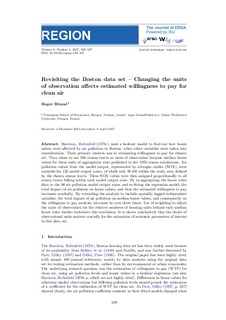| dc.contributor.author | Bivand, Roger | |
| dc.date.accessioned | 2017-08-10T07:42:05Z | |
| dc.date.available | 2017-08-10T07:42:05Z | |
| dc.date.created | 2017-06-01T10:15:00Z | |
| dc.date.issued | 2017 | |
| dc.identifier.citation | REGION. 2017, 4 (1), 109-127. | nb_NO |
| dc.identifier.issn | 2409-5370 | |
| dc.identifier.uri | http://hdl.handle.net/11250/2450355 | |
| dc.description.abstract | Harrison, Rubinfeld (1978c) used a hedonic model to find out how house values were affected by air pollution in Boston, when other variables were taken into consideration. Their primary interest was in estimating willingness to pay for cleaner air. They chose to use 506 census tracts as units of observation because median house values for these units of aggregation were published in the 1970 census tabulations. Air pollution values from the model output, represented by nitrogen oxides (NOX), were available for 122 model output zones, of which only 96 fell within the study area defined by the chosen census tracts. These NOX values were then assigned proportionally to all census tracts falling within each model output zone. By re-aggregating the house value data to the 96 air pollution model output zones and refitting the regression model, the total impact of air pollution on house values, and thus the estimated willingness to pay, increases markedly. By extending the analysis to include spatially lagged independent variables, the total impact of air pollution on median house values, and consequently on the willingness to pay analysis, increases by over three times. Use of weighting to adjust the units of observation for the relative numbers of housing units behind each median house value further buttresses this conclusion. It is shown conclusively that the choice of observational units matters crucially for the estimation of economic parameters of interest in this data set. | nb_NO |
| dc.language.iso | eng | nb_NO |
| dc.publisher | European Regional Science Association | nb_NO |
| dc.rights | Attribution-NonCommercial-NoDerivatives 4.0 Internasjonal | * |
| dc.rights.uri | http://creativecommons.org/licenses/by-nc-nd/4.0/deed.no | * |
| dc.subject | spatial data analysis | nb_NO |
| dc.subject | spatial econometrics | nb_NO |
| dc.subject | system articulation | nb_NO |
| dc.subject | entitation | nb_NO |
| dc.title | Revisiting the Boston data set. Changing the units of observation affects estimated willingness to pay for clean air | nb_NO |
| dc.type | Journal article | nb_NO |
| dc.type | Peer reviewed | nb_NO |
| dc.description.version | publishedVersion | nb_NO |
| dc.source.pagenumber | 109-127 | nb_NO |
| dc.source.volume | 4 | nb_NO |
| dc.source.journal | REGION | nb_NO |
| dc.source.issue | 1 | nb_NO |
| dc.identifier.doi | 10.18335/region.v4i1.107 | |
| dc.identifier.cristin | 1473408 | |
| cristin.unitcode | 191,30,0,0 | |
| cristin.unitname | Institutt for samfunnsøkonomi | |
| cristin.ispublished | true | |
| cristin.fulltext | original | |
| cristin.qualitycode | 1 | |

